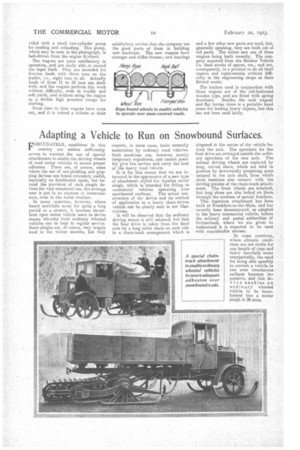Adapting a Vehicle to Run on Snowbound Surfaces.
Page 10

If you've noticed an error in this article please click here to report it so we can fix it.
FOW! 1.7XAT.ELY, conditions in this country are seldom sufficiently severe to warrant the use of special attachments to enable. the driving wheels of road motor vehicles to secure proper adhesion. There are, of course, cases where the use of non-skidding a,nd gripping devices are found extremely useful, especially on frostbound roads, but beyond the provision of such simple devices for very occasional use, the average user is put to no expense or inconvenience, even in the worst weather.
In many countries, however, where heavy snowfalls occurfor quite a long period at a stretch, it becomes incumbent upon motor vehicle users to devise means whereby their ordinary wheeled vehicles can be kept in regular service. Snowssleig•hs are, of course, very largely used in the winter months, but they (meaute, in some eases, tasks normally undertaken by ordinary road vehicles. Such machines are, however, merely temporary expedients, and cannot possibly give the service and carry the load of the heavy road vehicle.
It is for this reason that we are interested in the appearance of a new type of attachment styled the Aquilan motor sleigh, which is-Intended for fitting to commercial vehicles operating over snowbound surfaces. The actual construction of the device and its method of application to a heavy chain-driven vehicle can be clearly seen in our illustrations.
It will be observed that the ordinary driving means is still retained, but that the final drive is taken from the dead axle by a long roller chain on each side to a chain-track arrangement svhich is disposed in the centre of the vehicle -be• hind the axle. The sprockets for the final drive are arranged outside the ordinary sprockets of the rear axle. The normal driving wheels are replaced by long, curved shoes, which are held in position by downwardly projecting arms secured to the axle shaft, from which stout members also connect with the
• driving pinions of the chain-track attach. ment. The front wheels are retained, but long shoes are also bolted on them through the medium of special brackets. This ingenious attachment has been built at Frankfort-on-the-Main, and has recently been demonstrated, as adapted to the heavy commercial vehicle, before the military and postal authorities of Switzerland, where we are given to understand it is expected to be used with considerable success.
In earns countries, where climatic condi
tions are not stable for any length of timeand heavy snowfalla 'occur unexpectedly, the need for being able speedily to convert a vehicle to run over treacherous surfaces becomes im• perative, and this de. vice enables all ordinary wheeled vehicle to be transformed into a motor sleigh in 30 mine.






























